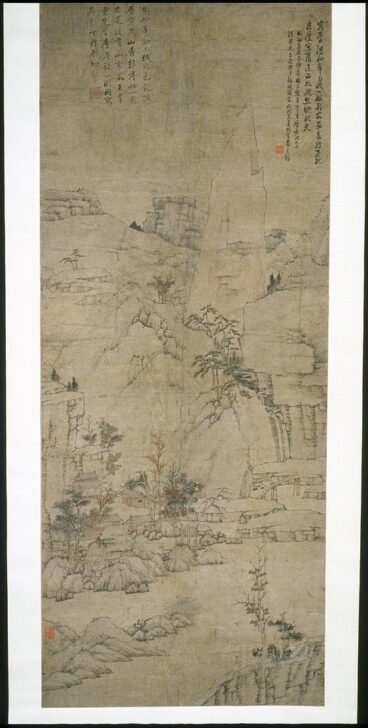Picture of the Cinnabar Peak
Sun Yi

Description
Sun Yi
China, active mid-17th century
Picture of the Cinnabar Peak
Qing dynasty (1644–1911)
1657
Hanging scroll, ink and light color on paper
Gift of Professor Richard and Vee Ling Edwards, 1987/1.155
This landscape was created not long after the Ming dynasty (1368–1644) had fallen to the Manchus. It is likely a politically- charged metaphor for the exiled Ming court’s struggle to regain power during the early years of the Manchu-ruled Qing dynasty.
It depicts Mount Huang (Yellow Mountain), located in Anhui province in south-central China, a favorite subject
of poets and painters for centuries. The familiar scene has an unexpected feature: a prominent red peak jutting above the surrounding green mountains. This addition to the topography is meant to covertly express the artist’s loyalty to the Ming court. According to his inscription, the painting
is based on a description of Mount Lu by the writer Wang Siren (1575–1646), known for resisting Manchu rule. Wang describes the mountain as “a red-colored [cinnabar] castle on fire,” whose “high pinnacle almost pierces through the many layers of clouds.” The pronunciation of the character for cinnabar in Chinese is similar to the name of the Ming royal family. In 1657, the year the painting was made, the last Ming ruler—the final hope for the restoration of a Ming government—had been forced to flee. The use of metaphor disguises the artist’s political leanings, reducing the risk
of persecution.
Subject Matter:
This work depicts Mount Huang (Yellow Mountain), located in Anhui province in south-central China. A site of extraordinary natural beauty noted for its range of rocky peaks, it was a favorite subject of poets and painters for centuries. For artists from the region, including Sun Yi, whose hometown was at the foot of the peaks, Mount Huang was an inexhaustible theme. After the Ming dynasty (1368–1644) fell to the invading Manchus, Mount Huang took on a particular political significance. The isolated red peak towering/jutting above the surrounding green mountains in this painting most likely alludes to the struggle of the failing Ming court against the onslaught of the Manchus. This interpretation is strengthened by the artist’s inscription, which references/quotes a description of Mount Lu by the writer Wang Siren (dates?), known for his loyalty to the Ming court. Wang describes the mountain as “a red-colored castle on fire,” whose “high pinnacle almost pierces through the many layers of clouds.” [These words in combination with the image suggest Sun Yi’s [hopes for the eventual triumph of [Manchu-ruled Qing].
Examples of Sun Yi’s painting are extremely rare; The Cinnabar Peak, his only painting outside of China, is by far the finest example. (171 words)
Physical Description:
This is a delicate landscape. There are mountain crags, dispersed trees and bushes, and some houses/huts depicted. There is calligraphy on the upper right hand corner with one red seal, and towards the upper left corner with a red seal. There is also another red seal on the lower left hand corner. The colors are muted and are barely discernable from one another. There is a central jutting rock in the center of the painting that takes up a lot of horizontal space, and encourages the eye to travel upwards.
Usage Rights:
If you are interested in using an image for a publication, please visit https://umma.umich.edu/request-image/ for more information and to fill out the online Image Rights and Reproductions Request Form.